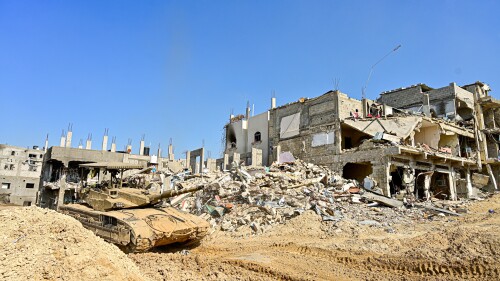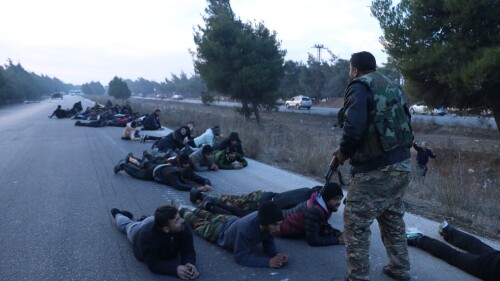Recent statements by the Yemeni Ansar Allah (Houthis) movement and by two prominent Iraqi Shi’ite militias reflect the close levels of cooperation and coordination between different elements of the Iranian-led Mehwar al-Muqawama (Resistance Axis) in the region.
The statements consist of threats against Israel, Saudi Arabia, and the United States. Of particular note is the focus on Saudi Arabia by these organizations. What’s behind these latest statements, and what may they imply for the direction of events?
The Houthis on July 7 issued a video titled Just Try it, which showed drone footage and coordinates of several sites in the Saudi kingdom.
Among the areas shown were King Khalid International Airport in Riyadh, King Abdulaziz International Airport in Jeddah, King Fahd International Airport in Dammam, and the ports in Ras Tanura, Jizan, and Jeddah.
The release of the video coincided with a rare speech by Ansar Allah leader Abdul al-Malik al Houthi, in which he issued a series of direct threats against the Saudis.
“America is trying to entangle you,” the Yemeni Shi’ite Islamist leader said. “And if you want that, just try it. If you want good for yourselves, stability for your country and your economy, stop your conspiracies against our country. If the Americans succeed in entangling you, it is a terrible stupidity and great failure, and it is our natural right to confront any aggressive steps.”
The real cause for the threats against Riyadh relates not to the war against Israel but to Houthi fears of financial disaster if the Riyadh-supported government in Aden goes through with plans to sanction banks operating in Houthi-held areas.
The Iraqi Ktaeb Hezbollah’s statement, issued on the organization’s official Telegram channel Kaf on July 13, accused Riyadh of permitting its “land routes” to be used to “perpetuate the momentum of the war against the Palestinians, as an alternative to the sea routes,” and threatened that the “Kingdom of Evil” would “pay the price for its actions as its masters paid it in the Red Sea” (a reference to the ongoing attacks on international shipping by the Houthis in the Red Sea/Gulf of Aden area).
On July 15, an official of the Iraqi Shi’ite Nujaba movement, Firas al Yasser, told the pro-Hezbollah Lebanese newspaper al-Akhbar that “the Iraqi resistance has recently focused on Saudi Arabia, especially in the areas that affect it, as it found in the battle of the Flood of Al-Aqsa sufficient and comprehensive information about the amount of support that the usurping entity [i.e., Israel] was receiving, despite the siege imposed on it by the Iraqi resistance and the Yemeni armed forces [Houthis]...
“There are corridors from the Emirates, Saudi Arabia, Egypt, Jordan, some Gulf countries, and Turkey to deliver supplies to the enemy. If the trade balance between these countries and Israel were reviewed, we would find that trade increased significantly after the battle of the Flood of Al-Aqsa.”
The al-Akhbar article, notably, went on to quote unnamed “resistance” sources in Iraq, according to whom “the resistance is studying the resumption of its operations against American bases,” following what they described as the effort by the US to avoid withdrawal from Iraq.
Nujaba, like Ktaeb Hezbollah, is an IRGC-supported Iraqi Shi’ite militia.
Away from the rhetorical declarations against Israel, however, Al-Yasser later in the interview with al-Akhbar went on to outline what appears to be the true background to the sudden focus by the Houthis and their Iraqi friends on Saudi Arabia: “The recent escalation with the Houthis regarding the banks in Sana’a necessitates that there be qualitative operations against Saudi interests.”
Lone wolves
THE NUJABA official here reveals that the real cause for the threats against Riyadh relates not to the war against Israel but rather to Houthi fears of financial disaster if the Riyadh-supported government in Aden goes through with plans to sanction banks operating in Houthi-held areas, under money laundering and anti-terrorism laws.
Yemen has been under a situation of de facto partition since 2015, when the Houthis captured its capital, Sana’a.
In 2016, the official, Saudi-supported Yemeni government moved the central bank to Aden in the south, its center of activities.
In March, the Houthis announced the launch of their own currency as part of a move toward complete independence from the central bank in Aden.
In March, the Houthis announced the launch of their own currency as part of a move toward complete independence from the central bank in Aden.
The Saudi-supported government responded in April with an ultimatum, giving banks 60 days to relocate from the Houthi-controlled area or face sanctions.
No banks met the deadline, and in June the central bank in Aden banned dealing with six banks in Sana’a.
The Houthis have few external sources of foreign currency or financial assistance.
According to a report in the Associated Press, people banking in areas under their control have begun to experience difficulties withdrawing their funds.
The report notes that while no formal restrictions have been announced, the Houthi-controlled central bank in Sana’a has stopped releasing funds deposited by individual banks because of a lack of liquidity.
The threats from the Houthis and their two allied militias are thus not directly motivated by the Gaza war.
They are intended to intimidate the Saudis and to force them and the government they support in Aden to back off from following through with a policy that could cause serious harm to the Houthi-controlled government in Sana’a.
On the other hand, the stand taken by the Iraqi Shi’ite militias confirms the extent to which events in the region are linked.
Not because of any direct Saudi role in the Gaza war as alleged by al-Yasser but because the fight against the Saudi- and United Arab Emirates-supported authorities in Yemen, the campaign to expel US forces from Iraq, and Hamas’s war against Israel all constitute separate fronts in a single conflict.
Prior to the outbreak of the war in Gaza, there was much reporting in the Israeli media concerning the desire of the Iranian-led regional camp for the “unity of the arenas” (Wihdat al sahaat).
This meant that at a certain moment, a unified assault involving the entirety of Iran’s militia assets throughout the region would be launched. Since this did not happen following October 7, the term has since fallen in prominence.
“Unity of the arenas” describes an ongoing, already existing reality in which Iran’s client militias are, and perceive themselves to be, engaged in a single, region-wide struggle with various fronts.
The latest statements from the Houthis, Ktaeb Hezbollah, and Nujaba, however, indicate that this slogan is not necessarily meant to refer to a single moment.
Rather, it describes an ongoing, already existing reality in which Iran’s client militias are, and perceive themselves to be, engaged in a single, region-wide struggle with various fronts.
In this regard, it is worth noting that the Houthis last week announced the opening of an office for their organization in Baghdad, in the Jadriya district, close to the Green Zone.
The office was inaugurated by an Iraqi-based Houthi official, Abu Idris al-Sharafi.
He is known for his close links to the Popular Mobilization Units, the body that formalizes the IRGC-linked Shi’ite militias as an element of Iraq’s official armed forces.
The coordinated statements by the Houthis and the Iraqi Shi’ite militias threatening Saudi Arabia, the effort to connect the separate issue of the Yemeni banking system to the Gaza war, and the evidence of growing, ongoing cooperation between the militias on the ground are all reflective of the extent to which Iran is managing its regional alliance as a unified whole.
It is interesting to note that the propaganda of the “Resistance Axis” continues to imagine that its opponents have a similar unity of purpose. This is not yet the case.








